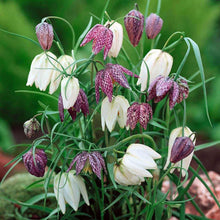
Native to the Scandinavian Peninsula, growing in wet meadows or floodplains. Fritillaria grows easily in grass or drained but damp soil in the sun or half shade, but does not like being dried out completely. The leaves are narrow and can be lost in grass; the flowers are beautiful, square-shouldered bells in pink, mauve and darker purples, lightly checkered. Inside they are paler, splashed with shining green. Fritillaria meleagris has been awarded the RHS Award of Garden Merit. It naturalizes easily and attracts pollinators.
Each stem produces several bell-shaped purple (sometimes white) flowers that are decoratively checkered. Naturalise well in a permeable, constantly humid place. The bulbs are sensitive to dehydration: plant immediately after receipt.
💐 DETAILS
• Position: Part-shade
• Type: Checkered Lily, perennial
• Height at maturity: 30 cm
• Flowering time: April-May
• Soil: Rich, humus; constantly moist but still well draining
• Rate of growth: normal
• Hardiness: fully hardy
• Bulb size: 6/7
✔️ Suited for:
• Cut flowers and bouquets
• Pots, large containers
• Woodlands, meadows, borders, cottage gardens
• Low maintenance gardens
🔗 See all of our fall-planting bulbs here: https://www.etsy.com/shop/terracegardenfrance/?etsrc=sdt§ion_id=43298036
👩🌾 CARE
All spring-flowering bulbs must be planted in the fall.
Fritillaria meleagris bulbs should be planted in small drifts of 5-7 bulbs 4" (10cm) apart and about 4" (10cm) deep at variable spacing (10-15 per sq ft) in heavier soils in the open or slight shade, perhaps in rough grass. They should be planted in late summer or early autumn, to allow rooting to start before the soils cool. Higher rainfall in the spring will encourage them rather than years of winter drought.









